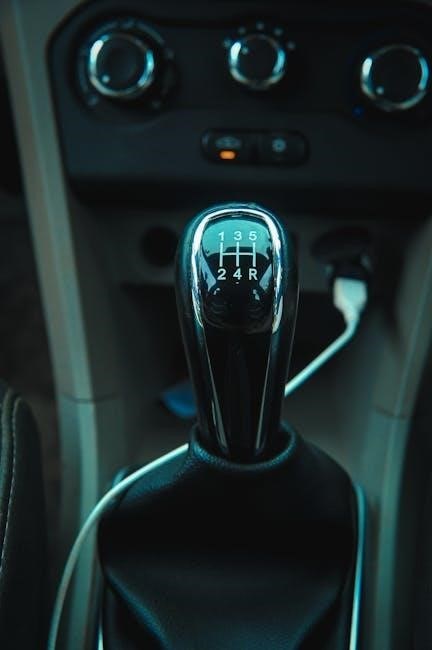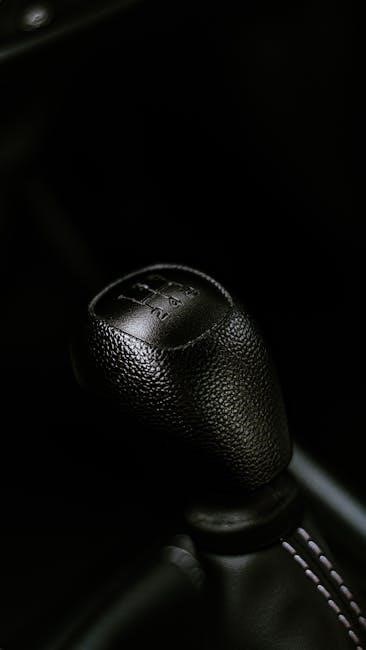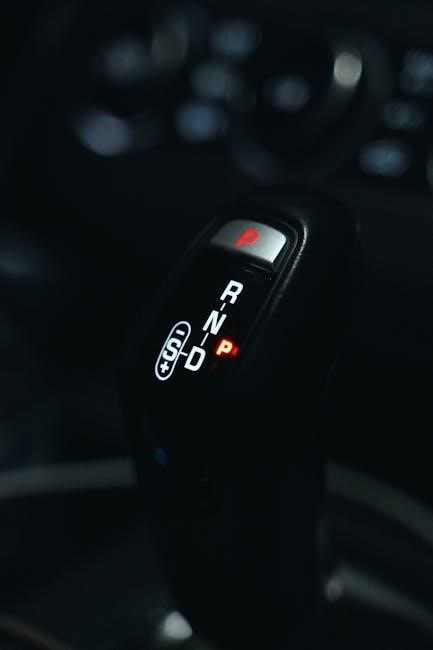The Mustang manual transmission symbolizes a connection between driver and machine, offering precise control and an engaging driving experience rooted in the car’s iconic legacy, blending tradition with performance.
1.1 Historical Overview of Manual Transmissions in Mustangs
Manual transmissions have been a cornerstone of the Mustang’s identity since its debut in 1964. The original TopLoader transmission set the standard for driver engagement. Over the decades, advancements like the T-5 in the 1980s and the Tremec in the 1990s refined performance and durability. These transmissions became synonymous with the Mustang’s reputation as a driver-focused, high-performance vehicle, blending tradition with innovation to maintain its iconic status among enthusiasts.
1.2 Importance of Manual Transmissions in the Mustang Legacy
Manual transmissions have played a pivotal role in shaping the Mustang’s legacy, embodying the spirit of driver engagement and automotive passion. They represent a direct connection between the driver and the vehicle, fostering a sense of control and intimacy. For decades, enthusiasts have celebrated the manual transmission as a symbol of the Mustang’s heritage, reinforcing its identity as a performance-driven icon. This timeless appeal continues to resonate with purists and collectors, ensuring the manual transmission remains an integral part of the Mustang’s enduring legacy.
“The manual transmission is more than just a gearbox—it’s a link to the Mustang’s soul,” say many enthusiasts. This sentiment underscores its cultural significance, making it a cherished feature in the Mustang’s history.

Buyer’s Guide to Mustang Manual Transmissions
The Mustang manual transmission offers a blend of performance and tradition, making it a sought-after choice. Buyers should consider model years, budget, and reliability to find the perfect fit.
Researching key differences in transmission models and understanding maintenance needs can help buyers make informed decisions, ensuring their Mustang delivers the driving experience they desire.
2.1 Choosing the Right Model Year
When selecting a Mustang with a manual transmission, the model year plays a crucial role in performance, features, and reliability. Earlier models, such as the 2005 V8 Mustang, offer a classic driving experience, while newer editions like the S197 Ford Mustang provide improved engineering and modern amenities. The S197, for instance, is praised for its balance of power and handling, making it a popular choice among enthusiasts. Buyers should research specific years to align with their preferences, whether prioritizing affordability, heritage, or cutting-edge technology.
2.2 Key Differences Between Various Mustang Models
Mustang models vary significantly in terms of drivetrain, engine, and features, impacting manual transmission performance. The S197 Ford Mustang, for example, is known for its V8 power and rear-wheel-drive configuration, while newer models like the GT Performance Edition offer enhanced suspension and aerodynamics. Transmission options differ too, with the MT82 and Tremec being notable for their durability and smooth shifting. Each model year balances tradition with innovation, catering to diverse driving preferences, whether for daily commuting or track performance.
2.3 Cost Considerations and Budgeting
When considering a Mustang with a manual transmission, budgeting involves initial purchase, maintenance, and potential repairs. Manual transmissions are often more affordable than automatics, with lower purchase and repair costs. However, high-performance models or specialty transmissions may increase expenses. Regular maintenance, such as fluid changes and clutch replacements, should be factored in. Upgrades, like aftermarket components, can also add to the cost. Balancing performance needs with budget is crucial for long-term ownership satisfaction and financial stability.
2.4 Reliability and Longevity Factors
The reliability and longevity of a Mustang manual transmission depend on factors like model year, maintenance, and driving habits. Modern manual transmissions are built to last, with many owners reporting high mileage without major issues. Regular fluid changes and clutch replacements are essential for extending lifespan. Older models may experience wear in synchros or gear engagement over time. Proper driving techniques, such as smooth shifting and avoiding rider wear, significantly impact durability. Overall, manual transmissions are known for their robust design and long-term reliability compared to automatics.

Maintenance and Repair of Mustang Manual Transmissions
Regular maintenance, including fluid changes and clutch inspections, is crucial for ensuring the longevity of a Mustang manual transmission and preventing costly repairs down the line.
3.1 Routine Maintenance and Service Tips
Regular maintenance is essential for the longevity of a Mustang manual transmission. Fluid changes every 30,000 to 60,000 miles ensure smooth gear engagement and prevent wear. Inspect the clutch for wear and replace it if slipping occurs. Check for any leaks around seals and gaskets. Replace the transmission filter every 50,000 miles to maintain clean fluid flow. Lubricate the shift linkage and bearings annually to keep shifting smooth. Always follow the owner’s manual guidelines for service intervals and use high-quality parts to ensure reliability and performance.
3.2 Common Issues and Troubleshooting
Common issues with Mustang manual transmissions include difficulty shifting gears, clutch slipping, and fluid leaks. If gears grind or stick, check for worn clutch pads or misaligned gear teeth. Slipping clutches may indicate worn facings or improper pedal adjustment. Leaks around the transmission pan or seals should be addressed promptly to prevent fluid loss. Regular inspection of the shift linkage and bearings can prevent loose or erratic shifting. Always refer to the owner’s manual for troubleshooting steps, and consider consulting a mechanic for persistent or complex problems to avoid further damage.
3.3 DIY Repair Tips and Tricks

For DIY enthusiasts, repairing a Mustang manual transmission can be rewarding. Start by gathering a service manual and essential tools. Replacing the clutch or adjusting the shift linkage are common tasks. Always drain transmission fluid carefully and use a pan to catch spills. If replacing seals, ensure surfaces are clean to prevent leaks. Bleeding the hydraulic system after repairs is crucial for smooth operation. Use online forums or repair guides for specific instructions. Remember, patience and attention to detail are key to successful DIY transmission work.

Performance Upgrades for Manual Transmissions
Upgrading your Mustang manual transmission enhances performance and driving dynamics. Consider lightweight components, high-performance gear sets, and improved clutch kits for better acceleration and control.
4.1 Popular Modification Options
Popular modifications for Mustang manual transmissions include lightweight flywheels, high-performance clutch kits, and upgraded gear sets for improved acceleration. Short-throw shifters enhance shifting precision, while carbon fiber driveshafts reduce weight and boost efficiency. Limited-slip differentials optimize traction, especially during aggressive driving. Cooling system upgrades, such as transmission oil coolers, prevent overheating under heavy use. Additionally, aftermarket transmission mounts improve stability and reduce vibration. These modifications cater to enthusiasts seeking enhanced performance, reliability, and a more engaging driving experience.
4.2 Choosing the Right Components for Enhancement
When enhancing a Mustang manual transmission, selecting the right components is crucial for optimal performance. Lightweight flywheels and high-performance clutch kits improve acceleration and reduce weight. Aftermarket gear sets offer better durability and faster shifting. Short-throw shifters and upgraded transmission mounts enhance precision and stability. Consider your driving habits—daily commuting vs. track use—to choose components. Always ensure compatibility with your specific Mustang model. Consulting with experts or enthusiast communities can help tailor upgrades to your needs, ensuring reliability and improved driving dynamics.
4.3 Impact of Upgrades on Driving Experience
Upgrading your Mustang manual transmission significantly enhances the driving experience, offering smoother shifts and quicker acceleration. Lightweight components reduce inertia, improving throttle response. Performance clutches and gear sets provide better durability and precision, especially in high-stress driving. Short-throw shifters reduce effort and travel, making gear changes faster and more intuitive. These upgrades not only boost performance but also elevate driver engagement, making the car feel more responsive and connected to the road. For enthusiasts, such modifications can transform the Mustang into a track-ready machine while retaining its daily drivability.

Manual vs. Automatic: Pros and Cons
The manual transmission offers driver engagement and cost efficiency, while automatics provide smoothness and ease, especially in traffic. Modern automatics often match manuals in performance and fuel efficiency.
5.1 Advantages of Manual Transmission
The manual transmission offers a more engaging and precise driving experience, allowing drivers to feel fully connected to the vehicle. Key advantages include:
- Fuel Efficiency: Manuals often achieve better fuel economy compared to automatics.
- Cost-Effectiveness: They are generally cheaper to purchase and maintain.
- Performance: Quicker acceleration and better control, especially in spirited driving.
- Driver Involvement: The tactile experience of shifting gears enhances the emotional connection with the car.
These benefits make manual transmissions a preferred choice for driving enthusiasts seeking both efficiency and excitement.
5.2 Benefits of Automatic Transmission
The automatic transmission offers unparalleled convenience and ease of use, making it ideal for daily commuting and city driving. Key benefits include:
- Convenience: No need to manually shift gears or use a clutch, reducing driver fatigue.
- Smooth Acceleration: Seamless gear transitions provide a more comfortable ride.
- Accessibility: Easier to operate for new or less experienced drivers.
These features make automatic transmissions a practical choice for those prioritizing comfort and simplicity over manual control.
5.3 Which is Better for Different Driving Needs
The choice between manual and automatic transmissions depends on driving habits and preferences. Manual transmissions are ideal for enthusiasts who enjoy driver engagement and precise control, especially in performance or track settings. They also offer better fuel efficiency and lower costs. Automatic transmissions, however, are more convenient for city driving, heavy traffic, and those who prioritize ease of use. For new drivers or those seeking comfort, automatics are the better option. Ultimately, the decision hinges on balancing performance, practicality, and personal preference.

Driving Techniques for Mustang Manual Transmissions
Mastering smooth acceleration, clutch control, and optimal gear shifting enhances the Mustang’s driving experience, ensuring precision and enjoyment on both city streets and open highways.
6.1 Mastering the Art of Shifting Gears
Mastering the art of shifting gears in a Mustang manual transmission requires finesse and practice. Start by familiarizing yourself with the clutch pedal’s “catch point,” where the engine begins to engage. Smoothly release the clutch while pressing the accelerator to avoid jerky starts. When shifting, use a firm but deliberate motion, ensuring the gear engages fully. Always match engine speed to the desired gear, especially when downshifting, to maintain control. Regular practice in a safe, open area can help refine your technique, making every drive more enjoyable and precise.
6.2 Tips for City and Highway Driving
For city driving, use smooth, gradual clutch engagement to navigate stop-and-go traffic effortlessly. In heavy traffic, consider shifting into neutral to reduce clutch wear. On the highway, maintain steady speeds in higher gears to optimize fuel efficiency and reduce engine strain. When approaching inclines, downshift to maintain power and control. Always anticipate traffic flow to avoid sudden gear changes, ensuring a smooth and comfortable ride in both urban and open-road environments.
6.3 Racing and Track Driving Techniques
When racing or track driving with a manual Mustang, precise control is key. Use aggressive shifting to maximize acceleration, keeping RPMs high for optimal power delivery; Downshift smoothly before corners to maintain control and traction. Rev-matching during downshifts prevents wheel hop and enhances stability. Brake in a straight line before turning to avoid unsettling the car. Stay focused on maintaining smooth, consistent inputs to handle the track demands effectively, ensuring the Mustang’s manual transmission performs at its best for a competitive edge.

The Future of Manual Transmissions in Mustangs
The Mustang manual transmission faces challenges from EVs but remains relevant due to enthusiast demand. Ford continues to innovate, blending tradition with modern performance for future models.
7.1 Impact of Electric Vehicles on Manual Transmissions
The rise of electric vehicles (EVs) poses a significant challenge to manual transmissions in Mustangs; As Ford transitions toward electrification, the traditional manual gearbox may face declining demand. However, enthusiasts argue that manuals offer a unique driving experience that EVs cannot replicate. Ford has hinted at maintaining manual options in certain models, even as hybrid and electric variants emerge. The shift toward EVs could redefine the role of manual transmissions, but their legacy and appeal may ensure their survival in niche markets, particularly among Mustang purists and performance-driven consumers.
7.2 Will Manual Transmissions Remain Relevant?
Manual transmissions may face challenges due to advancing automation and electrification, but their relevance endures among driving enthusiasts. Many purists argue that manuals provide a unique, tactile driving experience that automatics and EVs cannot replicate. While EVs dominate the future, Ford has indicated plans to retain manual options in select performance models, catering to niche markets. The emotional connection and mechanical engagement of manual transmissions ensure their continued appeal, even as the automotive landscape evolves. Their relevance will likely persist, albeit in more specialized roles, as driving culture adapts to technological shifts.
7.3 Evolution and Innovation in Transmission Technology
Manual transmission technology in Mustangs has evolved significantly, blending tradition with modern innovation. Recent advancements include improved gear ratios, lightweight materials, and refined synchronizers for smoother shifting. The introduction of the Tremec TR-3160 in newer models exemplifies this progress, offering enhanced durability and performance. Additionally, Ford has explored hybrid and electric integration, ensuring manuals remain viable in an electrified future. These innovations underscore the commitment to maintaining the driving experience while adapting to technological advancements, ensuring manual transmissions stay competitive and relevant in modern vehicles.

Community and Resources

The Mustang manual transmission community thrives through dedicated online forums, local enthusiast clubs, and shared resources, fostering connections and knowledge among drivers and mechanics alike.
8.1 Forums and Online Communities for Enthusiasts
Online forums and communities dedicated to Mustang manual transmissions offer invaluable resources for enthusiasts. Platforms like Mustang Forums and Reddit’s r/Mustang provide spaces to discuss transmission maintenance, share modification ideas, and troubleshoot common issues. These communities are rich with firsthand experiences, technical advice, and recommendations from seasoned owners and mechanics. Engaging with these forums can enhance your understanding of manual transmissions and connect you with like-minded individuals who share your passion for the Mustang’s driving experience. They also often feature guides, tutorials, and reviews of aftermarket components.
8.2 Local Clubs and Meetups
Local Mustang clubs and meetups provide a hands-on way to connect with fellow enthusiasts, share knowledge, and celebrate the manual transmission’s role in the Mustang’s heritage. These gatherings often feature workshops, drives, and expert advice from experienced owners and mechanics. Attendees can learn tips for maintaining and upgrading their manual transmissions, as well as gain insights into the history and evolution of Mustang models. Joining local clubs is a great way to build friendships and stay informed about upcoming events and activities tailored to manual transmission enthusiasts.
8.3 Recommended Reading and Viewing
For enthusiasts seeking to deepen their knowledge, recommended reading includes books like Mustang: The Complete History and Ford’s official Mustang Manual Transmission Service Guide. These resources provide detailed insights into maintenance, upgrades, and historical context. Additionally, YouTube channels like Mustang Tech offer step-by-step repair tutorials and performance enhancement tips. Online forums and communities also share valuable experiences and recommendations, helping owners optimize their manual transmissions effectively. These materials cater to both novices and seasoned enthusiasts, offering a comprehensive understanding of the Mustang’s manual transmission.
The Mustang manual transmission embodies a timeless blend of performance, tradition, and driver connection, ensuring its legacy endures as a cornerstone of automotive enthusiasts’ passion and engineering excellence.
9.1 Summary of Key Points
The Mustang manual transmission has been a cornerstone of its legacy, offering a direct connection between driver and vehicle. Historically, it has symbolized performance and driver engagement. Maintenance and upgrades are crucial for longevity, with DIY options available for enthusiasts. The debate between manual and automatic highlights unique benefits for different driving needs; Performance enhancements and proper driving techniques maximize its potential. Despite the rise of EVs, the manual transmission remains a celebrated feature, blending tradition with innovation. Its enduring appeal ensures its place in automotive culture, making it a timeless choice for enthusiasts.
9.2 Final Thoughts on the Mustang Manual Transmission
The Mustang manual transmission embodies the spirit of driving purism, connecting drivers to the road with precision and passion. Its enduring appeal lies in the tactile experience it offers, making every drive memorable. While modern advancements and EVs reshape the automotive landscape, the manual transmission remains a cherished part of the Mustang’s identity. For enthusiasts, it symbolizes freedom, control, and a deep bond with the vehicle. As technology evolves, the manual transmission stands as a testament to tradition and performance, ensuring its place in automotive history for years to come.
